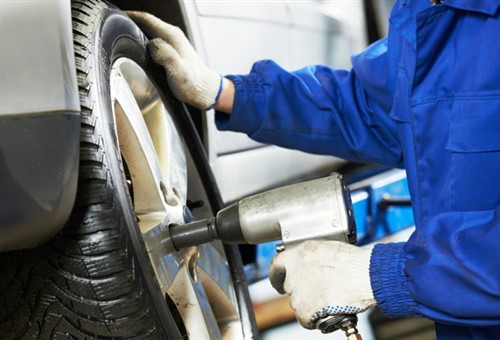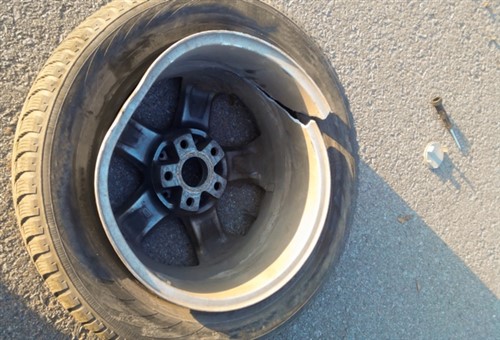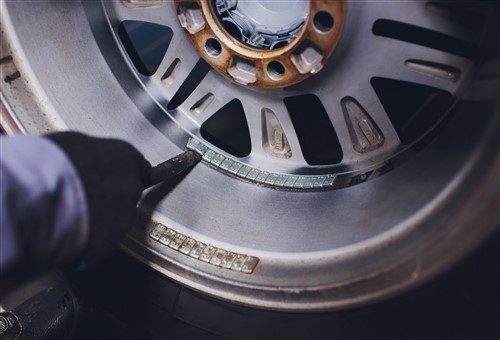
Although wheel and tyre service are not among the top three most glorious things we do in our daily lives as mechanics and technicians, this writer was recently reminded of the importance of doing wheel and tyre services right when he got involved in diagnosing an odd vibration on a 2016 Ford Mustang with less than 4 000 km on its clock. The root cause of the odd vibration was rather shocking not only because two specialist tyre fitment centres had failed to locate the problem, but also because a tyre fitment centre that should have known better had created the problem.
In this article, we will discuss this case as a suitable background against which to view wheel and tyre services, as well as revisit some of the basic, yet best practices to follow when we work on the wheels and tyres of our customer’s vehicles. Before we get to specifics, though, let us state-
In the interest of full disclosure, this writer must state that he has never been a fan of Ford Mustangs- in any of its iterations. The reasons for this are not important or relevant to this article, so when the owner of a local tyre fitment centre recently invited this writer to consult on an odd vibration in a Ford Mustang, he was slightly less than enthusiastic about the idea of working on one of his least favourite cars.
In fact, this writer had turned down invitations to consult on Mustangs before, and he only accepted this invitation because a) the car now belonged to the son of a (now deceased) long-time customer, and b) the owner of the tyre fitment centre was a long-time acquaintance and erstwhile colleague of this writer. We can skip over the history of this particular Mustang, except for saying that the father bought the car new as a retirement present to himself in 2016, and only undertook one cross-country trip with it before suffering a stroke, which forced him to put the car into storage.
Sadly, the father died without ever regaining the ability to drive, and so the car remained in storage for several years before his son took possession of it as a part of his inheritance. To make a long story short, the afflicted Mustang enters this story when the son had the old tyres on the car replaced immediately upon taking possession of the car- and then spent the next three weeks trying to have the odd vibration in what was essentially a new car diagnosed and resolved, which brings us to-
Nothing seemed to be out of the ordinary upon this writer’s initial inspection of the Mustang, which was immaculate: it seemed to have just rolled off the factory floor, and that “new car” smell was still faintly evident in the car’s interior. Some initial research showed that the car was fitted with the original, 20-inch factory rims fitted with high-end high-performance tyres that showed no evidence of uneven or irregular wear. This was not surprising, seeing that the tyres have covered less than 100 km.
To make things easier, the car’s new owner brought along the old tyres, but seeing that these tyres have only covered about 4 000 km, they also showed no evidence of uneven or irregular wear. Apart from their age, all the old tyres were in perfect condition. The next step was to review the wheel alignment report, but this showed that all the alignment settings were within a few per cent of the OEM-recommended settings.
According to the both car’s owner and the owner of the tyre fitment centre, who had test-driven the Mustang, the vibration was felt mostly in the driver’s foot well, but also in the driver’s seat, but to a lesser extent. Also according to the tyre fitment centre’s owner, the vibration started at about 60 km/h, got worse until about 80 km/h, and then tapered off above speeds of 80 to 90 km/h.
Somewhat strangely, neither the fitment centre's owner nor the car's owner said anything about a vibration on the steering wheel, so this writer invited the fitment centre's owner to accompany him on a test drive. Sure enough, the vibration appeared in the driver's footwell at about 60 km/h, got worse until we reached about 80 km/h, and then gradually disappeared as we went past 80 km/h.
These symptoms clearly pointed to a wheel balance problem, but since there was no sign of vibration on the steering wheel, there had to be something else wrong, although exactly what that "something" was, was unclear at that moment. Upon our return to the tyre fitment centre, the establishment’s owner volunteered the information that the technician who mounted and balanced the wheels reported some difficulty with balancing the right front wheel, so this writer called the technician over to explain the "difficulty" he'd had with balancing the front wheel.
It turned out that the wheel required a total balancing counterweight of 110 grams, which, at the time, struck the technician as slightly excessive, but since the wheel ran perfectly true on the wheel balancer, the technician, as he put it “…kept on sticking weights in different places inside the rim until he’d gotten an imbalance of fewer than 3 grams, which he thought was acceptable.
Long story short: this writer asked for the wheel to be removed, and sure enough, there were at least 15 weights scattered around the inside of the rim. This was definitely not the way to balance a 20-inch rim, but out of curiosity, this writer placed the wheel on a balancing machine, and just like the technician said, the rim/tyre combination ran perfectly true. So, if the rim was not bent, the problem must involve the tyre, so this writer asked for all the balancing weights to be removed from the rim, and for the tyre to be replaced with an identical replacement.
As it turned out, replacing the tyre did not resolve the problem, since it took another fifteen or so weights in total (and in virtually the same places on the rim) to rebalance the wheel to within 3 grams, which, according to the local Ford dealership, was indeed within allowable limits on this particular model. Therefore, and since none of the other wheels on the car required counterweights of more than 20 grams the problem had to involve the rim itself in some way, which brings us to-

Of course, the solution did not jump out at this writer, but since there was no point in switching a wheel with a 110-gram imbalance to another position on the car to see if the problem moved with the wheel, this writer had the problem front wheel removed again so he could inspect it from up close. It is perhaps worth mentioning that since the problem rim was powder coated like the original factory rims, as opposed to being painted, it was possible that the thick coating could mask some kind of defect that was not visible during a casual inspection. This turned out to be the case, but the kind of problem this writer found was both shocking and alarming, at the same time.
Under normal light, there did not seem to be anything wrong with the rim. However, when this writer shone a bright light obliquely across the inside of the rim, he saw clear evidence of what seemed to be two diverging welding seams running diagonally from the bead area on the inside of the rim to about three-quarters of the way to the outside bead area. Once the defect was visible, running a hand over the area confirmed the presence of an irregularity on the rim’s surface that should most definitely not have been there.
The image at the top of this section shows a rim that was fractured in much the same way that the rim on the Mustang must have been fractured, which raised the questions of when the rim was fractured, and who had decided that it was a good idea to straighten out and weld a 20-inch alloy Mustang wheel rim. It was more than likely that the rim broke during the road trip, and since new Mustang rims are hugely expensive, the current owner’s late father probably accepted a tyre fitment centre’s bad advice and chose to have the rim “repaired” instead of having it replaced. Sadly, though, the car’s current owner was unable to confirm these assumptions at the time.
Nonetheless, the most likely root cause of why the Mustang was vibrating in the way it did now seemed clear. Although the wheel had been straightened out to run true, the tow welds that kept the pieces together did not restore the rim’s structural strength and rigidity. Thus, as the wheel rolled, the weight of the car and the almost non-existent flexibility of the low-profiled tyre likely caused the rim to deform around the welds, which caused the rim to run out of true in its plane of rotation, as opposed to wobbling at a tangent to its plane of rotation.
This explained why there was no vibration on the steering wheel, but it did not explain why the vibration went away at a certain road speed. Logic would dictate that the rim’s deformation around the weld seams would progressively increase as the wheels’ rotational speed increased thereby increasing the vibration. It was, of course, likely that a complex combination of opposing forces cancelled out the imbalance(s) in the welded rim beyond a certain road speed, but as it turned out, this question was never resolved to this writer’s satisfaction.
Not that it mattered much; the Mustang’s owner resolved the matter by ordering a hugely expensive new rim from the local Ford dealership, which resolved the vibration definitively when it arrived three weeks later. The Mustang’s owner also found a $2000 invoice from a tyre fitment centre in another city among his late father’s papers that dated from the time his father was doing his road trip in his new Mustang. If nothing else, the invoice answered the question of who thought it was a good idea to repair the rim by welding its several pieces together.
For obvious reasons, this writer will not name this tyre fitment centre here. However, the saddest part of this saga is that the invoice amount was for a repair that should not have been done simply because such repairs are inherently dangerous, and as such, this ill-considered “repair” put the car owners’ life at serious risk for the sake of a few dollars.
At this juncture, you might wonder if there is a point to this story. You may well ask because there is indeed a point to this story and it involves the fact that-

The technician who stuck 110 grams’ worth of balancing weights on the Mustang’s rim could perhaps be forgiven for not having detected the “repair” on the rim, given that the rim was not visibly bent or deformed, there were no signs of uneven tyre wear, there were no discernable vibrations on the steering wheel, and the wheels were properly aligned.
Then again, no rim, and especially a large-diameter rim, should require the number of balancing weights this writer saw on the Mustang’s rim, or the number of weights shown in this, similar, example without arousing suspicion that there is/was something seriously wrong with the rim. To his credit, though, the technician did report that he had experienced some trouble with balancing the wheel, but was that enough?
That is not for this writer to say, but what he can say is that most of us remove and refit wheels without thinking about it too much, or spending any time looking for expertly hidden welds on alloy rims when we perform any sort of tyre and/or wheel service on our customer’s vehicles.
However, having said the above, it must also be said that since the ride quality and handling characteristics/dynamics on modern vehicles are becoming increasingly more sophisticated with every new model release. Therefore, even relatively minor mistakes and oversights on our part when we fit wheels could potentially have serious negative consequences for our customers in terms of their driving experience and safety.
Thus, with the above in mind, this writer would like to share his basic approach to wheel and tyre service on modern vehicles here, You may already have a similar system or approach, but for readers who do not have a systematic approach to this least glamorous of maintenance procedures, here is how this writer does it-
Scan the whole vehicle for trouble codes
This is to identify possible issues with systems like the TPMS that could potentially affect the operation of one or more ADAS systems- many of which rely on both the tyre inflation pressures and wheel diameters to be within OEM-specified parameters.
All present trouble codes are recorded and presented to the customer for their consideration, who, more often than not, will authorize the repair of safety-critical systems if they understand the potential consequences of not repairing some types of faults.
Check and verify the condition of the tyres
This is best done with the wheels removed from the vehicle. Things to look out for are signs of tread separation, broken or shifted steel belts, the presence of bulges or protrusions on both the sidewalls and tread, as well as the usual things like cuts, cracks, or signs of dry rot.
Check the condition of wheel fasteners
One of the best ways to test the condition of fasteners is to see if all the nuts screw onto all studs by hand. In practice, it should be possible to screw any wheel nut onto any stud, so any binding, sticking, or tightness is always a sign that the studs are stretched from over-tightening, which could cause such studs to break when next they are loaded. Replace all suspect nuts, studs, and bolts as a matter of course.
Check if all wheels run true
If you have access to a wheel balancer, use it to check that all wheels, including the spare wheel, run true. Once you start doing this on regular basis, you’ll be amazed how often you come across rim/tyre combinations that are balanced but run out of true, without evidence of uneven wear on the tyres.
This is also a good time to check and verify that all balancing weights are secure and not about to go flying off the rim at high speeds.
Implement the R.I.S.T. protocol
So the word "protocol" might come across as a bit pretentious, but in the real world, this set of steps represents time-proven best practices to follow when refitting the wheels on any vehicle. Here is how it works-
Following all of the above steps may take a little more time than we are used to, or willing to spend on wheel services, but this is always time well spent when we discover potentially life-threatening defects on tyres and/ or rims that would have gone unnoticed had we not spent the additional time, which leaves us with this-
Even though tyres are our customers’ direct link to the road, it would not be unreasonable to say that most of our customers only think about the condition of their tyres and wheels when the time comes for them to replace their tyres.
Moreover, since most car owners do not realise that striking a pothole, kerb, or other obstruction in the road even at low speeds could potentially cause irreparable damage to their tyres and rims, it is up to us, as mechanics and technicians to educate our customers on how easy it is to damage a modern tyre even if such damage may not be visible to them.
However, this writer has long ago learned that many customers do not listen to or follow sound advice, but even so, by following both best practices and OEM-level service information when we perform wheel services, we can still contribute to our customer’s safety on the road without them even knowing about it, and that can never be a bad thing.